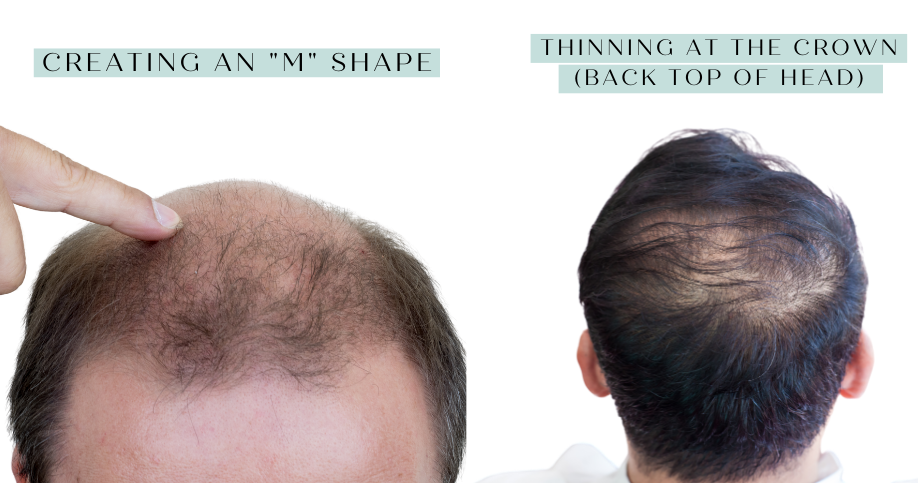Hair loss for men more then women
Look around at any gathering, and you'll likely notice something obvious – there are more balding men than women. This isn't just what we casually observe. The numbers back it up: by age 50, about half of all men show clear signs of hair loss, while only a quarter of women face similar issues.
So why this big difference? Let's break down the reasons in simple terms and look at what options are available, from medical treatments to hair wigs and patches.
It's All About That Male Hormone
The main reason men go bald more often comes down to a hormone called DHT (dihydrotestosterone), which comes from testosterone – the primary male hormone.
How DHT Harms Hair
In men whose families have a history of baldness, DHT does something very specific:
-
It shrinks hair follicles over time
-
It makes hair grow for shorter periods before falling out
-
Eventually, it causes follicles to grow hairs so tiny they're barely visible
Men naturally make much more testosterone than women do. More testosterone means more DHT can be created, which explains a big part of why men lose hair more often.
Women Have Natural Protection
Women have two hormonal advantages when it comes to keeping their hair:
-
They make much less testosterone, so there's less DHT
-
Their estrogen (female hormone) helps block DHT's harmful effects on hair
This is why many women don't see serious hair loss until after menopause, when their estrogen levels drop significantly.
For men dealing with DHT-related hair loss, options like mens hair wigs, hair patches, and hair systems offer immediate improvements while medical treatments work on the underlying issue.
Different Balding Patterns
Genetics don't just determine if you'll lose hair – they also control how and where you'll lose it.
The Male Pattern
Men's hair loss follows a predictable path:
-
Usually starts with a receding hairline at the temples, creating an "M" shape
-
Often includes thinning at the crown (back top of head)
-
These two balding areas might eventually connect
-
Hair on the sides and back usually stays thicker longer
This pattern makes men's hair loss very noticeable and hard to hide without specific solutions like mens hair patches or a well-fitted man's wig.

The Female Pattern
Women lose hair differently:
-
Usually thins across the whole top of the scalp rather than in specific spots
-
Often keeps the front hairline intact
-
Creates a widening part rather than obvious bald spots
-
Rarely progresses to complete baldness
This more spread-out thinning means women can often hide their hair loss with styling tricks, hair toppers, or ladies wigs for much longer before others notice.
The Genetic Unlucky Draw for Men
Recent science has found another important factor: a specific gene on the X chromosome affects hair loss.
One X Chromosome vs. Two
Men get only one X chromosome (from their mother), while women get two (one from each parent). This creates a big difference:
-
If a man inherits an X chromosome with the baldness gene, he has no "backup" copy
-
Women with one affected X chromosome usually have a second, normal copy that provides protection
This explains why male baldness often follows the mother's family line – a man's baldness risk is strongly influenced by his mother's father's hair status.
For men with strong genetic tendencies toward baldness, hair systems and mens wigs offer good solutions that work regardless of genetics.
Different Scalp Structure
The physical differences between male and female scalps also contribute to different balding patterns.
Fat and Collagen Differences
Research shows that men's scalps generally have:
-
Less fat under the skin than women's scalps
-
Less collagen (a protein that provides structure)
-
Different blood vessel patterns
These differences affect how hair follicles are fed and supported. Women's greater scalp fat provides better cushioning and blood supply to hair follicles, potentially offering some protection against hair loss triggers.
Starting Earlier: The Time Factor
Male pattern baldness often starts surprisingly young:
-
Up to 25% of men show balding signs by age 21
-
By age 35, about two-thirds of men experience some hair loss
-
Nearly 85% of men have noticeably thinner hair by age 50
Women typically don't see obvious thinning until their 40s or 50s, with changes after menopause speeding up the process. This earlier start gives male pattern baldness more time to advance to later stages.
For young men facing early hair loss, options like hair patch men solutions provide age-appropriate coverage that maintains a youthful look.
Beyond Genetics: Lifestyle Affects Men Differently
Several lifestyle and environmental factors seem to impact men's hair more than women's.
Stress Response Differences
Research suggests that men and women handle ongoing stress differently:
-
Men typically produce more stress hormones
-
Prolonged stress may interact differently with male hormones
-
Stress-related inflammation may affect DHT-sensitive hair follicles more severely
Diet Impacts
Dietary factors affect hair health differently between men and women:
-
Iron deficiency, more common in women, rarely causes male pattern baldness
-
Protein needs for hair growth may be higher in men
-
Some studies suggest male hair follicles are more sensitive to certain dietary factors
For men experiencing faster hair loss due to lifestyle factors, temporary solutions like mens toupees or mens hair patches can restore confidence while addressing underlying issues.
Why Male Baldness Has Survived Evolution
From an evolutionary standpoint, the common occurrence of male pattern baldness raises questions – why would a trait that seems to offer no advantage remain so widespread?
Some scientists think male baldness might have served as:
-
A sign of maturity and wisdom in society
-
A signal of testosterone levels (potentially indicating reproductive fitness)
-
A cooling mechanism for the brain in early humans
While these theories remain speculative, they highlight that male baldness has been common throughout human history, as shown in ancient art and writings.
Today, men have far more options than our ancestors, with solutions ranging from medications to remarkably natural-looking hair systems and mens wigs.
Different Solutions for Men and Women
The different patterns and progression of hair loss between genders influence which solutions work best.
Men's Solutions
Men's distinct pattern loss typically requires:
-
Hair systems - Custom-designed men hair patches that target specific balding patterns
-
Mens hair wigs - Full coverage solutions for advanced hair loss
-
Toupee wigs - Partial coverage for crown or frontal thinning
-
Men's toupees - Traditional but greatly improved options for natural coverage
Women's Solutions
Women's widespread thinning patterns often benefit from:
-
Women's hairpieces - Targeted coverage that blends with existing hair
-
Ladies hair toppers - Partial solutions for crown thinning
-
Female hair toppers - Designed specifically for women's hair loss patterns
-
Women hair wigs - Full coverage options for advanced thinning
Medical Treatments: Different Approaches for Different Patterns
Medical treatments for hair loss show different effectiveness between men and women.
Finasteride: Works Better for Men
Finasteride (often sold as Propecia) blocks the conversion of testosterone to DHT, making it:
-
Very effective for many men
-
Not suitable for women who might have children due to birth defect risks
-
Mainly useful for male pattern hair loss
Minoxidil: Works for Both
Topical minoxidil (Rogaine) works for both men and women, though:
-
Men typically use 5% strength
-
Women generally use 2% strength
-
Men often see better results on crown thinning
-
Women typically respond better to minoxidil than to finasteride
For those wanting immediate results while medical treatments take effect, hair wigs and hair systems provide instant coverage and confidence.
The Emotional Impact: Different Social Expectations
Society's different expectations about hair loss significantly impact how baldness affects men versus women emotionally.
Some Acceptance for Bald Men
Male baldness has gained some social acceptance:
-
Many men choose to embrace baldness by shaving completely
-
Famous athletes and actors have normalized the bald look
-
"Bald and confident" is increasingly seen as attractive
Despite this growing acceptance, many men prefer to maintain their hair or replace lost hair with solutions like men's hair wigs or hair systems.
Women's Hair Loss Stigma
Women face different challenges:
-
Female hair loss remains less socially accepted
-
Hair is often more strongly tied to feminine identity
-
Fewer celebrated examples of women embracing hair loss
This difference means women often seek solutions like women toppers or ladies wigs earlier in the thinning process, while some men might wait until hair loss is more advanced.
Special Solutions for Different Balding Patterns
The distinct patterns of male versus female hair loss have led to the development of specialized solutions.
Men's Specialized Options
For male pattern baldness:
-
Hair patch men designs target the distinctive crown thinning
-
Mens hair patches with stronger attachment for active lifestyles
-
Men's hair systems customized for natural hairlines
-
Toupee wigs engineered for male styling preferences
Women's Customized Solutions
For female pattern thinning:
-
Silk toppers for natural part lines
-
Lace toppers with invisible hairlines
-
Women hair toppers designed for versatile styling
-
Ladies hair topper options with varied coverage areas
Other Types of Hair Loss: Gender Differences
While pattern baldness shows clear gender differences, other hair loss conditions affect men and women differently too.
Alopecia Areata
This immune system condition causing round bald patches:
-
Affects both men and women equally
-
Often appears differently in women vs. men
-
May interact differently with hormonal patterns
For those with alopecia areata, alopecia wigs specifically designed for complete coverage provide comprehensive solutions.
Traction Alopecia
Hair loss from pulling forces affects genders differently:
-
Women experience it more often due to tight hairstyles and extensions
-
Men typically experience this less frequently
-
Recovery patterns differ between men and women
Age-Related Changes: Different Timelines
Age-related hair changes beyond pattern baldness also show gender differences:
Men's Aging Hair
-
Tends to thin more dramatically with age
-
Often recedes significantly by senior years
-
May completely bald in pattern areas
Women's Aging Hair
-
Typically thins gradually throughout life
-
Rarely progresses to complete baldness
-
Often keeps more overall coverage into senior years
For older adults, natural wigs and human hair wigs provide age-appropriate coverage that maintains dignity and confidence.
Hair Loss During Medical Treatments
Medically-caused hair loss affects genders differently:
Chemotherapy Effects
-
Both men and women lose hair during treatment
-
Women often report greater emotional impact
-
Regrowth patterns after treatment may differ
Cancer patient wigs and chemo wigs designed specifically for sensitive scalps provide crucial support during treatment and recovery.
Other Hair Changes That Come With Balding
Hair loss often happens alongside other hair changes:
Men's Additional Changes
-
Possible changes in facial hair (mens beard, mens moustache)
-
Potential men eyebrows thinning
-
Body hair changes that match scalp changes
Women's Related Changes
-
Possible eyebrow thinning (addressed with fake eyebrows products)
-
Eyelash changes
-
Different body hair patterns
Conclusion: Why Understanding These Differences Matters
Understanding the biological, hormonal, and genetic reasons why men bald more than women helps inform better treatment approaches.
While men do experience higher rates and more dramatic patterns of hair loss, both men and women have access to increasingly advanced solutions. From medications targeting hormonal factors to cosmetic options like hair wigs, mens hair wigs, hair patches, and hair toppers, no one needs to simply accept unwanted hair loss.
If you're noticing hair thinning, we recommend reading our guide on How to Identify Early Signs of Hair Thinning to catch and address changes as early as possible.
Understanding the gender differences in hair loss helps create personalized approaches that address not just the physical side of hair restoration but also the emotional impacts that differ between men and women.
Hair Wigs by SC


